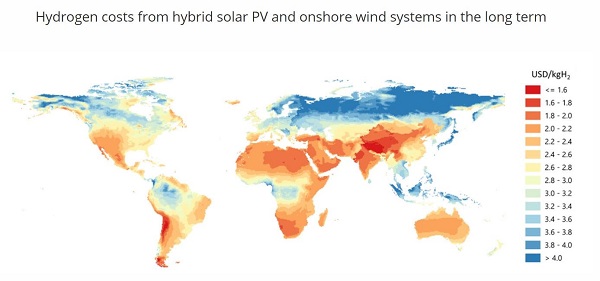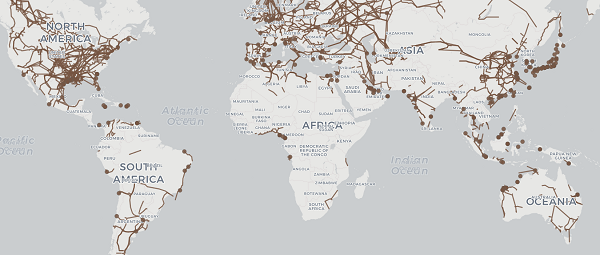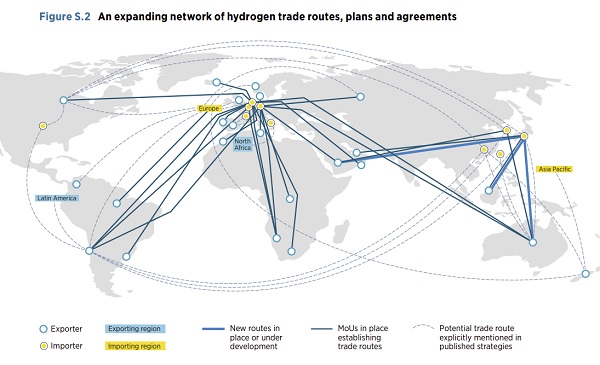If the world is to avoid climate catastrophe then it must rapidly cut down on fossil fuels. Many of the things the world currently uses fossil fuels for can be done with renewable electricity but others – like making steel and fuelling planes – cannot. For those, a potential alternative is to use hydrogen gas.
The International Energy Agency (IEA) says that to reach net zero emissions by 2050, the global energy system will need 150 million tonnes of “low carbon” hydrogen a year by 2030 and 520 million tonnes by 2050.
Currently, production of low-carbon or zero-carbon hydrogen is negligible. Even if all the world’s announced industrial plans are realised, the IEA says there will only be around 17 million tonnes of low-carbon hydrogen produced a year by 2030.
!function(){“use strict”;window.addEventListener(“message”,(function(e){if(void 0!==e.data[“datawrapper-height”]){var t=document.querySelectorAll(“iframe”);for(var a in e.data[“datawrapper-height”])for(var r=0;r<t.length;r++){if(t[r].contentWindow===e.source)t[r].style.height=e.data["datawrapper-height"][a]+"px"}}}))}();
This Climate Home News explainer will answer questions like: What is hydrogen and how is it made? What is it used for, what can it be used for and what should it be used for? How will it change our world?
What is hydrogen and how is it produced?
Hydrogen is a colourless, odourless gas with the chemical symbol ‘H’ and is the most abundant chemical substance in the universe.
It occurs naturally and can be produced in various ways, with different environmental impacts.
The vast majority of purpose-made hydrogen is made using fossil fuels. Around three-quarters is derived from methane gas and a quarter from coal. It can also be captured as a byproduct of industrial processes.
!function(){“use strict”;window.addEventListener(“message”,(function(e){if(void 0!==e.data[“datawrapper-height”]){var t=document.querySelectorAll(“iframe”);for(var a in e.data[“datawrapper-height”])for(var r=0;r<t.length;r++){if(t[r].contentWindow===e.source)t[r].style.height=e.data["datawrapper-height"][a]+"px"}}}))}();
Coal is the dirtiest feedstock. The coal is heated up to produce a gas with hydrogen, carbon monoxide and carbon dioxide and the hydrogen is captured to sell.
Producing hydrogen this way has a carbon footprint, according to the IEA, of around 20 kilogrammes of carbon dioxide (Co2) per kilogramme of hydrogen. Making hydrogen from methane gas, by processing it with steam, has around half the carbon footprint.
Both these methods release carbon dioxide. Some of this can be captured and stored so that it does not damage the atmosphere.
How much can realistically be captured is disputed. Companies like Equinor and Engie claim to capture 95% of it but Stanford engineering professor Mark Jacobson told Climate Home the figure was at most 79%.

(Source: International Energy Agency)
The only zero-carbon way to produce hydrogen is by using electricity which has been produced in a carbon-free way like through using renewables or nuclear power.

Hydrogen is colour-coded depending on how it is made (Photo: Applied Economics Clinic)
The hydrogen is produced through a process known as electrolysis. An electric current is passed through water, splitting H2O into hydrogen (H2) and oxygen (O2). The hydrogen is captured and the oxygen is released into the atmosphere.
While it is zero-carbon, it can still have an environmental impact as it requires fresh water. IEA’s hydrogen researcher Jose Miguel Bermudez-Menendez warns that the regions with the biggest potential to generate surplus renewable energy generally have the least fresh water.
Regulations are needed so that green hydrogen producers don’t use fresh water but instead desalinate their own water, he says. That doesn’t significantly increase the producers’ costs, so “shouldn’t be a challenge” as long as rules are in place.
At the moment, dirtier forms of hydrogen are cheaper to produce. According the IEA’s 2021 hydrogen review, green hydrogen costs $3-8 per kilogramme. Making hydrogen from gas and capturing and storing some of the Co2 emissions costs $1-2 per kg. Making hydrogen from gas and not capturing the Co2 emissions costs $0.5-1.7.
This disparity is expected to reduce. In a 2050 net zero scenario, the IEA models that green hydrogen costs will fall to $1.2-3.5 per kg by 2030 in places with good renewables resources. High carbon prices would help make green hydrogen competitive against dirty alternatives.

By 2030, clean hydrogen will be closer to competitive with dirty hydrogen (Photo: IEA/Screenshot)
The IEA’s Bermudez-Menendez told Climate Home that production of “low-carbon hydrogen” is likely to increase “very fast”.
“Now whether this very fast is aligned with a [global] net zero emissions scenario [by 2050], that’s a different question”, he added.
Under the IEA’s global net zero by 2050 scenario, in 2050 around 60% of hydrogen is produced by electrolysis (mainly from renewables) and 40% is produced by gas with carbon capture.
What can it be used for?
Hydrogen can replace fossil fuels in transport, industry and heating buildings. Between them, these three sectors make up around 41% of the world’s emissions.
Just because it can be used in all these areas though, it doesn’t mean it should be. E3G hydrogen analyst Eleonora Moro said: “It should only be used in end uses where no alternative, and especially no more energy efficient decarbonisation options are available”.
Energy analyst Michael Liebriech has categorised potential uses of hydrogen from most to least desirable. At the most desirable, he has products which are very difficult to make another way – like fertiliser and chemicals. At the least desirable, he has sectors which can be easily electrified – like cars, heating and trains.

Michael Liebriech’s hierarchy of hydrogen uses. (Photo: Michael Liebriech)
This distinction is clearest in transport. The larger a vehicle gets and the further and faster it has to travel, the bigger and more powerful electric batteries have to be and the more suitable hydrogen fuel cells are as an alternative.
On land, hydrogen is more suitable for buses and trucks than for passenger cars.
On the sea, short-haul ferries can charge up electric batteries at their destination but a battery won’t take long-haul cargo ships to their destination. They are more likely to use hydrogen or hydrogen-derived fuels like ammonia in the future.
In the air, the power required to keep a plane in the air would require a battery that is too heavy for flight. The aviation industry is mainly focussed on “sustainable aviation fuel” made from biological material like trees, plants and algae. E-kerosene, made from refining hydrogen, is an alternative which does not cause deforestation or compete with food sources.
Transport and Environment’s aviation director Andrew Murphy told Climate Home E-kerosene was more sustainable than biofuels. However, it is currently far more expensive.

In both the US and EU, hydrogen-derived fuels (orange, blue, green) are expected to remain more expensive than today’s jet fuel (black), unless carbon taxes (diagonal stripes) are imposed.
(Photo: ICCT)
As with cars, heating and cooking are areas where hydrogen can replace fossil fuels like gas but is usually not the best option. Peter Taylor, chair of the UK Energy Research Centre, said that this was an early focus for hydrogen but “the story has moved on” and they’re likely to be electrified with heat pumps instead.
Hydrogen can replace fossil fuels in industry too. The low-hanging fruit is converting the industries which already use hydrogen – like oil refining and chemical production – from grey hydrogen to green hydrogen.
Oil refineries turn crude oil into various oil-based productions like petrol and use hydrogen to improve the oil and to remove impurities. About a third of the hydrogen they use is produced as a by-product of other processes and the rest is made specially.
Making chemicals like plastics and fertilisers also involves hydrogen in the form of ammonia. Demand for hydrogen for plastics is expected to grow and green hydrogen could meet it – although doing so is currently more expensive.
Heavy industries like iron, steel, cement and glass-making are harder to switch to green hydrogen. All these products need to produce a high heat to turn something into something else – iron into steel, sand into glass, clinker into cement. Fossil fuels are the primary source of this heat with around 65% coming from coal, 20% from gas and 10% from oil.
Most iron and steel is made in a blast furnace using coal and coke, which emit carbon dioxide. The industry produces 11% of global emissions, more than the European Union.
Efforts are underway to come up with economically viable ways of making carbon-free steel with hydrogen but the IEA says this is a “longer-term” ambition if the “technological challenges” can be overcome.
“In the long term it should be technically possible to produce all primary steel with hydogen,” the IEA says. But doing so would require vast amounts of hydrogen and, if that is to be green hydrogen, vast amounts of renewable electricity. Very low renewable electricity prices would be needed to make it competitive with traditional steel-making methods.
Another long shot is cement. It is the key ingredient in concrete and produces 4-8% of global emissions. To make cement, a mix of materials called clinker is heated up, usually by burning coal.
Taylor said: “While hydrogen has the potential to replace at least some of the coal used in cement making, there are still significant technical and economic challenges to be overcome and so it is unlikely to make a major contribution in the next 10 years”.
Hydogen can also be used to make electric power. Taiwan recently forecast getting 9-12% of its electricity from hydrogen in 2050. Bermudez-Menendez said electric power is not an immediate priority for hydrogen.
“It is more a complement for the latest stages of the decarbonisation process, for the latest bit of the power system that would be very difficult to decarbonise. In the short term, renewables and batteries are the urgent thing to do for power and industry and long-distance transport in hydrogen,” he said.

(Photo: IEA)
How will it affect geopolitics?
Fossil fuels, particularly oil and gas, are unevenly distributed around the world. Some countries – like Saudi Arabia, Russia, Norway and Venezuela – have lots of them. Others, like Europe and Japan, have relatively little.
About 80% of the world’s proven oil reserves are in just 14 countries, according to the Organization of Petroleum Exporting Countries (OPEC). These are the countries which stand to lose out from green hydrogen replacing oil and gas, although some (like Saudi Arabia) are also trying to embrace it.
The imbalance in fossil fuel reserves creates tensions that sometimes escalate into conflict. Countries with the fossil fuels can use them as political leverage, as Russia has been accused of doing to Europe recently and as Saudi Arabia did to the West in 1973. Countries without many fossil fuels may resort to violence when the supply is disrupted.
Renewable resources, and therefore green hydrogen potential, are more evenly distributed around the world. The International Renewable Energy Agency (Irena) projects that the “hydrogen business will be more competitive and less lucrative than oil and gas” and that “clean hydrogen will not generate returns comparable to those of oil and gas today”.
The German foreign office, which co-funded the Irena report, has a hydrogen diplomacy strategy to stimulate a global market. Hinrich Thoelken, a special advisor, told a conference in Berlin they were trying to create “a world where energy can less easily be weaponised”.
While some regions do have greater renewable capacity than others, most countries have either sun or wind. Regions which could produce green hydrogen cheaply include Chile, Australia, the Middle East and North Africa and South and Central Asia. Regions where green hydrogen production is more expensive include the far north and tropical rainforests.

The cost of producing green hydrogen. Red is the cheapest and blue is the most expensive (Photo: International Energy Agency)
Today, hydrogen is mainly produced close to the point of use, with very little global trade. There are no hydrogen export terminals. By 2030, the IEA expects 60 under its net zero by 2050 scenario. By 2050, it forecasts 150 around the world.
Creating a global market will depend on the cost of transport and development of standards.
The International Renewable Energy Agency (Irena) foresees a “dual market” for hydrogen. A regional market, where hydrogen is traded through pipelines and a global market for liquified hydrogen or ammonia, which can be shipped as a liquid and re-gasified at the destination.
Existing gas pipelines could be repurposed to carry hydrogen. But this is technically difficult and expensive, involving adaptations to the compressors and valves. And the geographic distribution of hydrogen producers and consumers does not map onto the methane gas network.
Gas-producing areas like northern Russia and Canada are linked to Europe and North America respectively through pipelines. But these areas are among the least promising for green hydrogen production. On the other hand, regions with high green hydrogen potential – like sub-Saharan Africa – have very few gas pipelines.

The world’s gas pipelines (Photo: Global Energy Monitor/Screenshot)
Where there are no pipelines, hydrogen can be turned from a gas into a liquid and loaded on to ships. The first such ship, carrying coal-made hydrogen, shipped its first cargo in January. A lot of fossil gas is transported in the same way, as liquified natural gas.
Hydrogen can also be converted to ammonia, a liquid, and transported. This ammonia can either be turned back into hydrogen gas or the ammonia can be used in some industries like for making chemicals or as a shipping fuel.
As well as transportation, a lack of standards could prove an obstacle to global trade as the buyer of hydrogen needs to know that it was produced in a zero-carbon way.
Despite the barriers to trade, wealthy countries in Europe, North America and East Asia are looking for sources of hydrogen. For example, Germany signed deals in the first half of 2022 with countries including India and UAE to support green hydrogen development.
For India, it fits with a mission to generate 5 million tonnes a year of green hydrogen by 2030, with Adani and Reliance Industries getting in on the action. For UAE, it is part of a strategy to diversify the economy away from oil and gas, although hydrogen is never going to bring the same superpower status.
Irena’s map of planned hydrogen trade routes (Photo: Irena/Screenshot)
This is the first in a series of four articles on the future of energy.
This article was updated on 19/7 to correct the erroneous statement that e-kerosene requires a bigger fuel tank than jet fuel.

